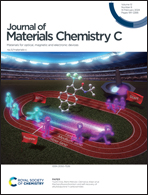Dicyclopentadithienothiophene-based non-fullerene acceptors for ternary blend organic photovoltaics†
Abstract
The ternary strategy can be used to optimize the light harvesting, energy level alignment, and blend morphology of organic photovoltaics (OPVs). Therefore, herein four non-fullerene acceptors (NFAs), INDCDTT-b16 (1), INFDCDTT-b16 (2), INClDCDTT-b16 (3) and INBrDCDTT-b16 (4), featuring dicyclopentadithienothiophene (DCDTT) as the core with soluble branched alkyl side chains with indanone (IN), and its fluoro-(INF), chloro-(INCl) and bromo-(INBr) derivatives as an electron-accepting end group, have been rationally designed and synthesized from simple and readily available starting materials for PM6:Y6-based ternary OPVs. The thermal, optical and electrochemical properties of 1–4 have been studied extensively. Following optimization, the power conversion efficiency (PCE) increased from 15.26% for the PM6:Y6 based OPV to 16.27% for the PM6:Y6:INDCDTT-b16 (1) based OPV. In contrast, ternary OPVs based on NFAs 2, 3, and 4 exhibited PCEs of 14.58%, 15.11%, and 15.14%, respectively. Through tapping-mode atomic force microscopy and grazing-incidence wide-angle X-ray scattering analysis, we confirmed that the introduction of NFAs into PM6:Y6 binary blend films/devices enables adjustment of the blend morphology, leading to improvements in carrier mobility, bimolecular/trap-assisted suppressed recombination, and charge collection. This study demonstrates that our NFA molecular design strategy and further addition of INDCDTT-b16 (1) as a guest acceptor are effective for the construction of high-performance OPVs.



 Please wait while we load your content...
Please wait while we load your content...